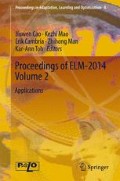Abstract
This paper proposes a Extreme Learning Machine (ELM) recognition framework for human activities using essential dynamic characteristics of the activity. Raw activity time series are collected from inertial sensors embedded in smart phone.We model each activity sequence with a collection of linear dynamical system (LDS) models, each LDS model describing a small patch of the sequence. A codebook is formed using the K-medoids clustering algorithm and a Bag-of-Systems (BoS) is developed to represent the activity time series. Then use ELM to classify them. Great advantages of this method are that complicated statistical feature design procedure is avoided and the LDSs can well capture the dynamics of the activity. Our experiment validation on public dataset shows promising results.
Access this chapter
Tax calculation will be finalised at checkout
Purchases are for personal use only
Preview
Unable to display preview. Download preview PDF.
References
Huang, G., Zhu, Q., Siew, C.: Extreme learning machine: theory and applications. Neurocomputing 70, 489–501 (2006)
Huang, G., Zhou, H., Ding, X., Zhang, R.: Extreme Learning Machine for Regression and Multiclass Classification. IEEE Trans. on Systems, Man, and Cybernetics, Part B: Cybernetics 42, 513–529 (2012)
Iosifidis, A., Tefas, A., Pitas, I.: Dynamic action recognition based on denemes and extreme learning machine. Pattern Recognition Letters 34, 1890–1898 (2013)
Deng, W.Y., Zheng, Q.H., Wang, Z.M.: Cross-person activity recognition using reduced kernel extreme learning machine 53, 1–7 (2014)
Minhas, R., Baradaran, A., Seifzadeh, S., Wu, Q.M.J.: Human action recognition using extreme learning machine based on visual vocabularies. Neurocomputing 73, 1906–1917 (2010)
Zhong, W., Huang, G.B.: Face recognition based on extreme learning machine. Neurocomputing 74, 2541–2551 (2011)
Mohammed, A.A., Minhas, R., Wu, Q.M.J., et al.: Human face recognition based on multidimensional PCA and extreme learning machine. Pattern Recognition 44, 2588–2597 (2011)
Liu, H., Sun, F., Yu, Y.: Multitask extreme learning machine for visual tracking. Cognitive Computation (January 2014)
Cheng, H., Liu, Z., Zhao, Y., Ye, G., Sun, X.: Real world activity summary for senior home monitoring. Multimedia Tools and Applications, pp. 1–4 (July 2011)
Cheng, H., Liu, Z., Hou, L., Yang, J.: Sparsity induced similarity measure and its applications. IEEE Trans. on Circuits and Systems for Video Technology PP, 1 (2012)
Lane, N.D., Miluzzo, E., Hong, L., Peebles, D., Choudhury, T., Campbell, A.T.: A survey of mobile phone sensing. IEEE Trans. on Communications Magazine 48, 140–150 (2010)
Wang, J., Chen, R.H., Sun, X.P., She, M., Kong, L.X.: Generative models for automatic recognition of human daily activities from a single triaxial accelerometer. In: Proc: of Int. Conf. on Neural NetWorks (IJCNN), pp. 1–6 (June 2012)
Doretto, G., Chiuso, A., Wu, Y., Soatto, S.: Dynamic textures. International Journal of Computer Vision 51(2), 91–109 (2003)
Liu, H., Xiao, W., Zhao, H., Sun, F.: Learning and understanding system stability using illustrative dynamic texture examples. IEEE Trans. on Education 57(1), 4–11 (2014)
Vidal, R., Chaudhry, R., Vidal, R.: Categorizing dynamic textures using a bag of dynamical systems. IEEE Trans. on Pattern Analysis and Machine Intelligence 35(2), 342–353 (2013)
McCall, C., Reddy, K., Shah, M.: Macro-class selection for hierarchical K-NN classification of inertial sensor data. In: Proc. of 2nd Int. Conf. Pervasive and Embedded Computing and Communication Systems (PECCS), pp. 106–114 (February 2012)
Baydogan, M.G., Runger, G., Tuv, E.: A bag-of-features framework to classify time series. IEEE Trans. on Pattern Analysis and Machine Intelligence 35(11), 2796–2802 (2013)
Saisan, P., Doretto, G., Wu, Y., Soatto, S.: Dynamic texture recognition. In: Proc. of Computer Vision and Pattern Recognition (CVPR), vol. 2, pp. 58–63 (2001)
Siddiqi, S.M., Boots, B., Gordon, G.J.: A constraint generation approach to learning stable linear dynamical systems. In: Proc. of Neural Information Processing Systems, pp. 1329–1336 (December 2007)
Cock, K.D., Moor, B.D.: Subspace angles between ARMA models. Systems and Control Letters 46(4), 265–270 (2002)
Martin, R.J.: A metric for ARMA processes. IEEE Trans. on Signal Processing 48(4), 1164–1170 (2000)
Author information
Authors and Affiliations
Editor information
Editors and Affiliations
Rights and permissions
Copyright information
© 2015 Springer International Publishing Switzerland
About this paper
Cite this paper
Wang, W., Yu, L., Liu, H., Sun, F. (2015). Extreme Learning Machine for Linear Dynamical Systems Classification: Application to Human Activity Recognition. In: Cao, J., Mao, K., Cambria, E., Man, Z., Toh, KA. (eds) Proceedings of ELM-2014 Volume 2. Proceedings in Adaptation, Learning and Optimization, vol 4. Springer, Cham. https://doi.org/10.1007/978-3-319-14066-7_2
Download citation
DOI: https://doi.org/10.1007/978-3-319-14066-7_2
Publisher Name: Springer, Cham
Print ISBN: 978-3-319-14065-0
Online ISBN: 978-3-319-14066-7
eBook Packages: EngineeringEngineering (R0)

